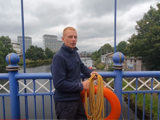Reducing vandalism
Reducing vandalism of Public Rescue Equipment in Glasgow
Data has shown that vandalism of Public Rescue Equipment (PRE) such as rescue rings, also known as lifebelts, along the River Clyde in Glasgow happens on a regular basis. This either compromises the effectiveness of the PRE, or renders it completely useless and therefore can have serious implications when the PRE is needed in an emergency rescue situation.
There are 670 lifebelts stationed along the River Clyde within the Glasgow city boundary. According to information from Glasgow Humane Society, on average around 80 of these lifebelts were being vandalised on a weekly basis.
In 2019, Glasgow City Council and the Glasgow Humane Society launched a campaign to address the issue, called "Taking a lifebelt is taking a life". The campaign was borne out of a tragic drowning incident in the area in 2016 which took the life of Christopher Spiers, aged 28. Christopher’s parents, Margaret and Duncan, have set up Christopher’s saving lives campaign, pushing for increased safety measures in the area, primarily the attachment of colour coded ropes to lifebelts throughout Scotland to make them more effective, recognisable and sustainable.
At the time that Christopher drowned, there had been no ropes attached to lifebelts along the Clyde since the 1970s. This campaign also recommends increasing the number of water safety information signs in the area and you can find out more about the work of the campaign on their Facebook page.
Following tireless campaigning from the Spiers family, and generous commitment and funding from Glasgow City Council, every lifebelt in the city will have a length of rope retrofitted to it. As outlined, this will enhance the effectiveness of the lifebelt and prolong its lifespan. The rope being used is a very special type of rope which has been developed in partnership with the Spiers family. They chose the colour purple (in tribute to Christopher) to be woven through the yellow-coloured rope which makes it unique and easily-identifiable as PRE rope. This rope cannot be bought ‘off-the-shelf’ and is only ever used in PRE which means that if it is stolen its origin can be quickly and easily traced.
The composition of the rope is new too, and differs from traditionally-used polypropylene rope which can burn the skin when pulling and is prone to knotting when being recoiled. The newly-developed PRE rope is constructed using a more suitable material which is soft and doesn’t easily tangle. As well as this, it is very strong, with a 2000lb breaking strain. The rope has been added to many of lifebelts along the River Clyde over the past 2 years and according to GHS this has resulted in a significant reduction in vandalism (over 50%).
William Graham, an officer from Glasgow Humane Society said, “This rope has been funded by Glasgow City Council and Glasgow Humane Society working in partnership with the Glasgow Water Safety Group and trialled for 2 years in Glasgow with great success. The rope is unique in design and has contributed to a decrease in vandalism since its installation throughout the City.
The rope has been used successfully in rescuing persons from the water. We are keen for other local authorities and beyond to consider adopting this rope as part of their Public Rescue Equipment.” Water Safety Scotland is a voluntary association of organisations and individuals whose main purpose is to understand the risks around water in Scotland and engage with partners to develop a consistent approach to the prevention of water-related fatalities.
Jen Foley from Water Safety Scotland said, “The development and adoption of this unique PRE rope by the Spiers family, Glasgow Humane Society and Glasgow City Council is an excellent step forward in water safety and we would encourage other local authorities in Scotland to follow Glasgow’s lead on this.” The development of this PRE-specific rope has been borne out of tragic circumstances and goes to show that the adoption of relatively simple interventions can yield truly significant results. For further information or discussion please get in touch using our contact form.

